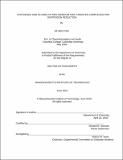Synthesis and studies of molybdenum and tungsten complexes for dinitrogen reduction
Author(s)
Chin, Jia Min
DownloadFull printable version (3.350Mb)
Alternative title
Synthesis and studies of Mo and W complexes for 2N reduction
Other Contributors
Massachusetts Institute of Technology. Dept. of Chemistry.
Advisor
Richard R. Schrock.
Terms of use
Metadata
Show full item recordAbstract
A series of monopyrroletriamine ligands [Arpyr(Ar')2]H3 of the form ArC4H2NHCH2N(CH2CH2NHAr')2 (Ar = 2,4,6-mesityl (Mes), 2,4,6-triisopropylphenyl (TRIP); Ar' = C6F5, 2-tolyl (o-tol), naphthyl, 3,5-(2,4,6-triisopropylphenyl)phenyl (HIPT), 3,5- dimethylphenyl, 3,5-di-tert-butylphenyl were synthesized. [Mespyr(C6F5)2]MoCl, ([Mespyr(C6F5)2]Mo = MesitylC4H2NCH2N(CH2CH2NC6F5)2) was prepared by reaction of [Mespyr(C6F5)2]H3 with MoCl4(THF)2 and base and [Mespyr(3,5-t-Bu)2]MoCl and [Mespyr(3,5- Me)2]MoCl (3,5-t-Bu=3,5-di-tert-butylphenyl, Me = 3,5-dimethylphenyl) were synthesized likewise. All three monochlorides are paramagnetic. [Mespyr(C6F5)2]MoNMe2, [[Mespyr(otol) 2]MoNMe2, [Mespyr(3,5-t-Bu)2]MoNMe2, [Mespyr(3,5-Me)2]MoNMe2 were synthesized by reaction of the ligands with Mo(NMe2)4. The resulting compounds are diamagnetic and range in color from teal blue to emerald green. These low spin monodimethylamide complexes exist in rapid equilibria with their high spin forms. [Mespyr(C6F5)2]MoN and [Mespyr(3,5-t-Bu)2]MoN were synthesized by reaction of their respective monochlorides with NaN3 and are yellow diamagnetic species. Reaction of [Mespyr(3,5-t-Bu)2]MoN with Et3OBF4 leads to {[Mespyr(3,5- t-Bu)2]MoNEt}BF4, also a diamagnetic yellow species. [Mespyr(C6F5)2]MoOTf is synthesized by the reaction of [Mespyr(C6F5)2]MoCl with AgOTf. Reduction of [Mespyr(3,5-t-Bu)2]MoCl with Na under N2 led to [Mespyr(3,5-t-Bu)2]MoNNNa(THF)x, several species with varying numbers of THF coordination, x. A single species can be obtained when [Mespyr(3,5-t- Bu)2]MoNNNa(THF)x is reacted with either NBu4Cl or 15-crown-5 ether to yield purple green 4 {[Mespyr(3,5-t-Bu)2]MoNN}NBu4 or [Mespyr(3,5-t-Bu)2]MoNNNa(15-c-5). All the diazenide species are diamagnetic. Oxidation of the diazenide with AgOTf yields [Mespyr(3,5-t- Bu)2]Mo(N2). [Mespyr(3,5-t-Bu)2]Mo(CO) is synthesized by exposure of [Mespyr(3,5-t- Bu)2]Mo(N2) to CO. Reaction of [Mespyr(3,5-t-Bu)2]MoCl with NaBPh4 and NH3 yields {[Mespyr(3,5-t-Bu)2]Mo(NH3)}BPh4. Catalytic runs employing [Mespyr(3,5-t-Bu)2]MoN as the catalyst yielded one equivalent of NH3. A triamidoamine ligand [(HIPTNCH2CH2CH2)3N]3- was synthesized and metalated with MoCl4(THF)2 to produce [(HIPTNCH2CH2CH2)3N]MoCl ([HIPTtrpn]MoCl). Reduction of [HIPTtrpn]MoCl by KC8 under an atmosphere of dinitrogen leads to the green species [HIPTtrpn]MoNNK which can be oxidized by ZnCl2(dioxane) to produce [HIPTtrpn]Mo(N2). Other complexes synthesized include {[HIPTtrpn]Mo(NH3)}+ salts and [HIPTtrpn]Mo(CO). Xray studies were carried out on [HIPTtrpn]MoN and {[HIPTtrpn]Mo(NH3)}BAr'4. This system is not catalytic for the reduction of dinitrogen to ammonia and studies were carried out to elucidate the reasons. Oxidation studies were carried out on [HIPTN3N]Mo(N2) and [HIPTN3N]W(N2) ([HIPTN3N] = [(HIPTNCH2CH2)3N]3-). The rate of conversion of [HIPTN3N]Mo(NH3) to [HIPTN3N]Mo(N2) was studied and found to be increased in the presence of BPh3. [HIPTN3N]Mo(N2) conversion to [HIPTN3N]Mo(CO) was found to be dependent on CO pressure. Protonation studies of [HIPTN3N]Mo(N2) were also carried out. Studies of [HIPTN3N]MoNNH decomposition showed that decomposition is not base-catalyzed. [HIPTN3N]W(CO) was synthesized by exposure of [HIPTN3N]W(N2) to CO. It is a green, paramagnetic compound and its use as a standard (for determining relative concentrations of other compounds in the IR sample) in IR spectroscopic studies appears to be promising. [HIPTN3N]MoCNH2 was synthesized by addition of acid and reducing agent to [HIPTN3N]MoCN and is a yellow, diamagnetic compound. Two triamidophosphine ligands, triHIPTamine and tri-n-Buamine were synthesized. Metalation of Zr(NMe2)4 with these ligands leads to formation of pn3HIPTZrNMe2 and pn3-n- BuZrNMe2, both diamagnetic, pale yellow complexes.
Description
Thesis (Ph. D.)--Massachusetts Institute of Technology, Dept. of Chemistry, 2010. This electronic version was submitted by the student author. The certified thesis is available in the Institute Archives and Special Collections. Vita. Cataloged from student-submitted PDF version of thesis. Includes bibliographical references.
Date issued
2010Department
Massachusetts Institute of Technology. Department of ChemistryPublisher
Massachusetts Institute of Technology
Keywords
Chemistry.